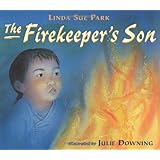
Average Reviews:

(More customer reviews)I don't know why I feel this way, but you'd think there would be a lot of Newbery winning children's authors who'd switch their focus from time to time to picture books. And yet, this is not the case. In fact, it's rather rare for someone of Lunda Sue Park's stature to go about writing for children younger than her usual fare. It's almost as if she's slumming. But Park (who won the Newbery for "A Single Shard") has discovered what most winners fail to realize. That a picture book can be every bit as morally complex and intricate as a 230-some page novel. All it takes is excellent writing and an illustrator who knows their stuff. Which makes, "The Firekeeper's Son" a perfect example of a picture book that does everything right and ends up wowing the reader with its intensity.
Sang-hee lives in a small, unassuming, and peaceful village in Korea. One day, his father informs him that their little space is infinitely important (a fact that Sang-hee has a bit of difficulty believing). But his father is absolutely correct. Located beside the sea and just next to the first of a row of mountains, it understood that in the event of a seaward attack by Korea's enemies, this village is the first line of defense. That is why, every night, Sang-hee's father climbs the nearby mountain and lights a fire that can be seen for miles. Then, someone on the next mountain will see that fire and light their own. This continues all the way to the king's palace where, if the king sees the last mountain lit, he'll know that all is well. Of course, if the fire is not lit, the king would immediately send his soldiers out to battle with the enemy. Now this system has gone on for generations, but Sang-hee is not content. He would love to see the king's glorious soldiers more than anything else in the world. Then, one night, his father hurts his ankle while climbing up the mountain. Sang-hee is given the task of lighting the fire himself, but as he nears the pile of dried twigs he thinks about how much he'd like to see a soldier up close. And the hot coals are slowly burning out...
The book weighs an individual's personal wants and fantasies against the greater good of the whole, and does so beautifully. You completely understand Sang-hee's dilemma. On the one hand, there's the fact that not lighting the fire would be a callous lie. On the other hand, "Maybe there is a soldier who would be glad for a chance to visit the sea". Park's story is based on factual information, as she mentions in her Author's Note. However, the system by which bonfires informed the king of potential attacks was, in real life, far more complex than the one featured here. As Park herself mentions, "additional fires could be lit to convey further information, so the court would know not only which province was facing danger but things like the size of the enemy forces and how well armed they were!". She provides additional resources for further reading.
It was a real stroke of luck that Park was paired with illustrator Julie Downing too. Downing plays with lush watercolors and pastels that perfectly convey not only the cool blue nights Sang-hee must run through, but also the glow of the slowly dying coals and eventual hot orange flames. If you look on the cover of the book, you can see dream soldiers fighting in the fire and the bright orange flickers reflected in the black of Sang-hee's eyes. Downing's images are the perfect compliment to Park's deeply rich story.
As historical fiction picture books go, this one has to be one of the most beautiful on record. If you'd like a picture book that lures those sometimes hard to interest boy readers, but is just as doggone interesting to the girls of the world, this book's a safe bet. It's beautiful to look at and remarkably complex to contemplate. Art in the purest sense.
Click Here to see more reviews about: The Firekeeper's Son

0 comments:
Post a Comment